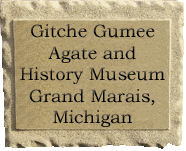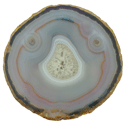MINERAL OF THE MONTH
September 2011 - Petoskey Stones
In 1965 the state stone for Michigan was designated as the Petoskey stone. Petoskey stones are fossils of coral colonies called Hexagonaria. "Hex" comes from hexagon, because the coral is usually a six-sided polygon. The coral grew 350 million years ago, 150 million years before the dinosaurs! It grew only in shallow tropical salt-water seas where lower Michigan is now. The coral stacked in layers, then fossilized into rock.
The Petoskey stones found on the beaches of Lakes Michigan and Huron were formed as a result of glaciation, in which sheets of ice plucked stones from the bedrock, grinding off their rough edges and depositing them primarily in the northern portion of Michigan's Lower Peninsula. In some areas of Michigan, complete fossilized coral colony heads can be found. The formations and specimens found inland tend to be rougher since they have not been weathered as much by the wind, water, and sand from the shoreline. The movement of the frozen lake ice acting on the shore during the winters is thought to turn over stones at the shore exposing new Petoskey stones at the water's edge each spring.
Similar fossil corals occur in a variety of locations; however the name Petoskey stone should only be applied to those from Michigan which exhibit a six-walled coral structure that has the distinctive "eye" pattern within each cell.
 |
When ancient glaciers pressed down on the center of the Lower Peninsula, the layer of fossilized coral rose up to form a ridge and created the dish shaped "Michigan basin". The exposed layer of rock is where Petoskey stones come from. Petoskey stones are found in the Gravel Point Formation of the Traverse Group. They are fragments of a coral reef that was originally deposited during the Devonian period. When dry, the stone resembles ordinary limestone but when wet or polished using lapidary techniques, the distinctive mottled pattern of the six-sided coral fossils emerges.
 |
 |
It is sometimes made into decorative objects. Other forms of fossilized coral are also found in the same location including the closely related favosites. Favosites is an extinct genus of coral characterized by polygonal closely-packed corallites (giving it the common name "honeycomb coral"). The walls between corallites are pierced by pores which allowed transfer of nutrients between polyps.
 |
|
The name comes from an Ottawa Indian Chief, Chief Petosegay. The city of Petoskey, Michigan, is also named after him, and is the center of the area where the stones are found. According to legend, Petosegay was the child of a descendant of French nobleman and fur trader, Antoine Carre and an Ottawa princess. Petosegay, meaning "rising sun", "rays of dawn" or "sunbeams of promise", was named after the rays of sun that fell upon his newborn face. In keeping with his promising name, Petosegay was a wealthy fur trader who gained much land and acclaim for himself and his tribe. He was remarked upon to have a striking and appealing appearance, and spoke English very well. He married another Ottawa, and together they had two daughters and eight sons. In the summer of 1873, a few years before the chief's passing, a city began on his land along Little Traverse Bay. The settlers christened the newborn city Petoskey, an anglicized form of Petosegay.
Mineral of the Month Archives
May 2007: Rainbow Fluorite
June 2007: Lake Superior Michipicoten Agate
July 2007: Labadorite
August 2007: Rain Flower Agate
Fall 2007: Malachite
December 2007: Nepheline Syenite
January 2008: Native Copper
February 2008: Amazonite
March 2008: Lake Superior Agate
April 2008: Shadow Agate
May 2008: Apohpylite
June 2008: Ocean Jasper
Summer 2008: Marra Mamba Tiger's Eye
September 2008: Mohawkite
October 2008: Mexican opal
November 2008: Prehnite
December 2008: Picture Jasper
January 2009: Sea Shell Jasper
February 2009: Polychrome Jasper
March 2009: Selenite Desert Rose
Spring 2009: Coyamito Agate
July 2009: Obsidian Needles
August 2009: Goethite
September 2009: Banded Iron Formation
Fall 2009: Fairburn Agate
March 2010: Fossilized Dinosaur Bone
April/May: 2010 Kentucky Agate
June 2010: Nantan Meteorite
July 2010: Mookaite Jasper
Aug/Sept 2010: Polyhedroid Agate
Fall 2010: Ammonite Fossil
September 2011: Petoskey Stones
Spring 2011: Petrfied Wood
Winter 2011: Argentina Condor Agate
January 2012: Mary Ellen Jasper
March 2012: Mexican Crazy Lace Agate
June 2012: Moqui Marbles
September 2012: Chlorastrolite Greenstone
March 2013: Jacobsville Sandstone
August 2013: Unakite
November 2013: Skip-an-Atom Agate
April 2014: Tiger's Eye
September 2014: Black Corundum
February 2015: Condor Agate
June 2015: Petoskey Stone
November 2015: Slag
June 2016: Lake Superior Copper Replacement Agates
March 2017: Chert
July 2017: Kona Dolomite
December 2017: Septarian Nodule
Copyright All rights reserved.
Gitche Gumee Museum.
E21739 Brazel Street
Grand Marais, Michigan 49839









